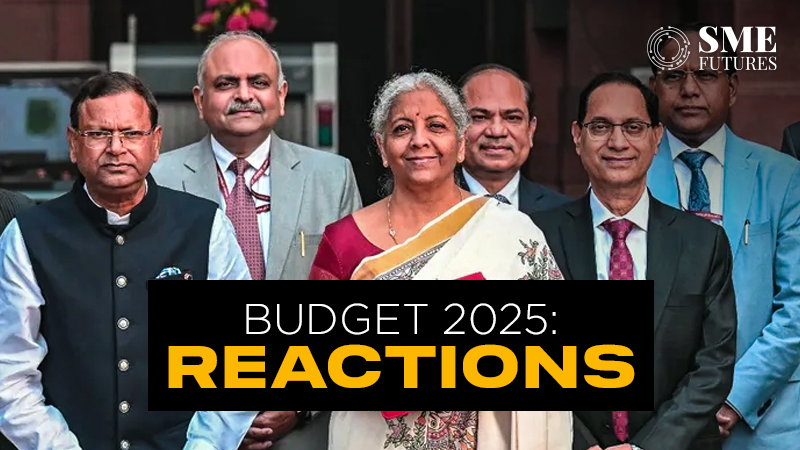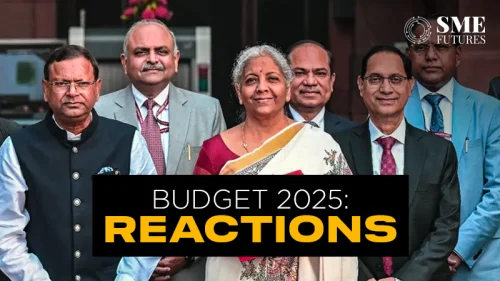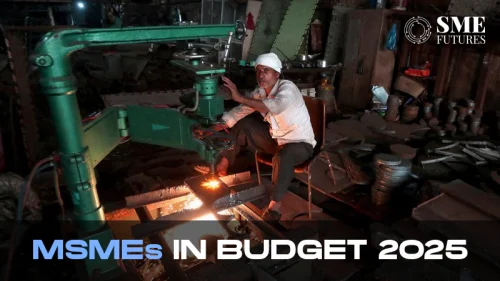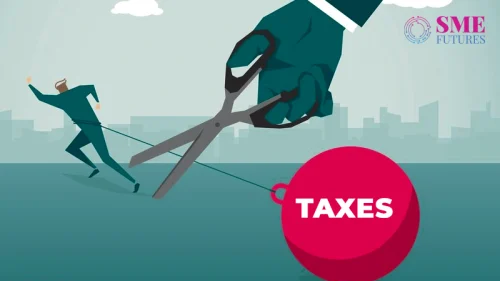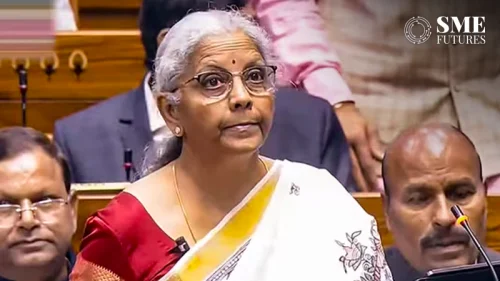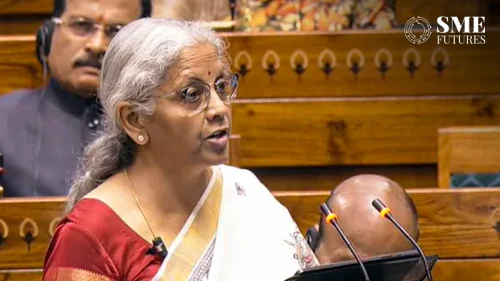On 1st February 2025, Finance Minister Nirmala Sitharaman presented her eighth Union Budget, aiming to invigorate the Indian economy through significant tax reforms and strategic investments. The budget seeks to enhance middle-class spending power, bolster agricultural productivity, and attract foreign investment, all while committing to fiscal consolidation.
Key numbers at a glance
The Indian government has set the total expenditure for the Union Budget 2025-26 at Rs 50.65 lakh crore, marking an increase from Rs 47.16 lakh crore in the revised estimates for 2024-25. In line with its fiscal consolidation strategy, the government has projected a fiscal deficit of 4.4 per cent of GDP, down from 4.8 per cent in the previous year’s revised estimates.
On the other hand, as per the Budget 2025 documents:
– Gross tax revenue is estimated at Rs 42.70 lakh crore.
– Net tax receipts for the Centre (after allocating the states’ share) stand at Rs 28.37 lakh crore.
– Non-tax revenue is projected at Rs 5.83 lakh crore.
– Capital receipts, including borrowings, are expected to reach Rs 16.45 lakh crore.
These allocations reflect the government’s focus on economic growth, infrastructure development, and fiscal discipline.
Suresh Darak, Founder, Bondbazaar comments, “In a challenging economic environment with slowing GDP growth, the budget could have taken a prudent approach by fiscal expansion rather than fiscal consolidation, reducing the fiscal deficit from 4.8 per cent in FY25 to 4.4 per cent in FY26. While this reflects a commitment to financial stability, a stronger push on capital expenditure could have further strengthened employment, business growth, and overall economic activity”
Here are some of the key Announcements:
1. Personal Income Tax Relief: In a move to boost consumption, the government has increased the income threshold for tax exemption. Individuals earning up to ₹1.28 million annually will now be exempt from income tax, with reduced rates applied to higher income brackets. This initiative is anticipated to cost the exchequer ₹1 trillion in revenue but is expected to stimulate economic activity by increasing disposable incomes.
2. Fiscal Deficit Reduction: Despite the substantial tax cuts, the government plans to narrow the fiscal deficit to 4.4 per cent of GDP, down from 4.8 per cent in the previous year. To finance this, gross borrowings are projected at ₹14.82 trillion, with net borrowings at ₹11.54 trillion.
3. Agricultural initiatives: The budget places a strong emphasis on agriculture, aiming to boost productivity, particularly in high-yield crops and cotton. The limit for subsidised farm credits has been raised, providing farmers with greater access to affordable financing.
4. Foreign Direct Investment (FDI) in insurance: In a bid to attract more foreign capital, the FDI cap in the insurance sector has been increased from 74 to 100 per cent. This move is expected to enhance competition and efficiency within the sector.
5. Manufacturing and exports: The government has introduced measures to bolster the manufacturing and export sectors, including the launch of the National Manufacturing Mission. This initiative aims to incentivise manufacturing through various support mechanisms and infrastructure development.
Economists have lauded the budget’s focus on stimulating consumption through tax reliefs, viewing it as a timely measure to invigorate demand amidst economic slowdowns.
“Today’s budget announcement solidifies our expectation of 6.6 per cent of GDP growth in 2025-26. No major surprises for the bond market with the market borrowings broadly in line with expectations. This along with the upcoming rate cuts and Open market purchases by the Reserve Bank of India, bond yields are expected to trend lower,” says Sakshi Gupta, Principal Economist, HDFC Bank.
Dr. Samantak Das, Chief Economist and Head of Research & REIS, India, JLL comments, “Budget is set to unleash animal spirits in the Indian economy. A wide-ranging push on people, industry and quality of life improvements across different sections of the population makes this a citizen-centric budget,”
The commitment to fiscal consolidation has also been well-received, reflecting prudent economic management. However, some experts caution that the success of these measures’ hinges on effective implementation and the government’s ability to manage the increased borrowing without stoking inflation. Let’s see what India inc is saying about the union budget 2025.
Bold budget for India
The Union Budget 2025-26 is a bold manifesto of India’s aspiration to solidify its position as a global economic powerhouse, says Sumit Kumar, Chief Strategy Officer at TeamLease Degree Apprenticeship. “With a strong emphasis on strategic investments in manufacturing, education, skilling, and inclusion, the budget lays the foundation for a future-ready workforce and sustainable economic growth, aligning with the vision of Amrit Kaal,” he says.
Radhika Gupta, MD & CEO at Edelweiss Asset Management feels, this budget boldly addresses the need of the hour: putting money into the hands of the middle class through meaningful tax reliefs. “This will energise consumption and growth at a critical time for the Indian economy,”
Changes in direct taxes
Finance Minister Nirmala Sitharaman announced that there will be no income tax payable for incomes up to Rs 12 lakh, and Rs 12.75 lakh for salaried taxpayers (including standard deduction).
In the new tax regime, the revised tax rate structure is Rs 0-4 lakh (zero tax), Rs 4-8 lakh (5 per cent), Rs 8-12 lakh (10 per cent), Rs 12-16 lakh (15 per cent), Rs 16-20 lakh (20 per cent), Rs 20-24 lakh (25 per cent), and above Rs 24 lakh (30 per cent).
Dr. Das comments, “The biggest announcement on personal income tax relaxation was a long-time coming and now provides enhanced liquidity in the hands of the middle-class, creating a perfect storm for reviving consumption demand. This will have a direct bearing on the housing sector with higher buying capacity supporting homebuying activity at robust levels.”
Edul Patel, CEO and Co-founder of Mudrex agreeing says, “The middle class can now save and invest more wisely. This opens up opportunities to explore a variety of wealth-building avenues, from traditional investments like mutual funds and stocks to digital assets like crypto. It encourages financial planning, empowering individuals to diversify their portfolios, and supports long-term wealth creation,”
More measures for MSMEs
The Union Budget 2025 has rightly emphasised the pivotal role of MSMEs in India’s economic landscape. With over one crore registered MSMEs contributing approximately 36 per cent to our manufacturing output and 45 per cent to exports, their significance cannot be overstated.
With this, the government’s decision to enhance the investment and turnover thresholds for MSME classification is a commendable move. Mukul Goyal, Co-Founder of Stratefix Consulting, says that this adjustment will enable more enterprises to avail MSME benefits, fostering growth and competitiveness. “The increase in credit guarantee cover for micro-enterprises from ₹5 crore to ₹10 crore is a significant step. This initiative is expected to inject an additional ₹1.5 lakh crore in credit over the next five years, empowering small businesses to invest in innovation and expansion,”
However, while these measures are promising, it is crucial to address the persistent challenges that MSMEs face, he says.
“Access to timely and affordable credit remains a hurdle for many small businesses. Streamlining the loan disbursement process and reducing bureaucratic red tape are essential to ensure that the intended benefits reach the grassroots level,” he adds.
Manufacturing mission for EoDB
The Union Budget 2025 sets a decisive course for India’s manufacturing sector by strengthening MSMEs, fostering domestic production, and enhancing global trade competitiveness. The enhanced credit guarantee scheme and financing for machinery upgrades will accelerate MSME expansion, fueling industrial growth, particularly in Tier II and III regions.
Bharat Gita, MD & CEO, Taural India commenting on the announcement of the National Manufacturing Mission says, “The mission coupled with a dedicated committee to review and reform business regulations, will improve the ease of doing business—streamlining processes, reducing bottlenecks, and attracting investments. Additionally, digital public infrastructure for international trade will unlock financing solutions, giving Tier II and III industries better access to global markets,”
Furthermore, a strong push for innovation through private-sector-driven research and 10,000 PM Research Fellowships will strengthen India’s R&D ecosystem, fostering high-value manufacturing advancements.
“By equipping researchers with resources to develop globally competitive technologies, these initiatives will help India move up the value chain—ensuring our industries are not just production hubs but innovation powerhouses,”
Expanding IIT capacity by 6,500 seats will further drive engineering excellence and future-ready talent.
Fresh startups funds
According to experts, the renewal of the ₹10,000 crore commitment to the Fund of Funds for AIFs is a significant step forward for the Indian startup and investment ecosystem.
“The initial ₹10,000 crore commitment catalysed ₹91,000 crore in investments, and I fully expect this fresh infusion to attract an additional ₹1 lakh to ₹1.5 lakh crore in capital. This initiative will provide much-needed growth capital to early-stage startups, further strengthening India’s position as a global innovation hub. We are supremely excited about this development and look forward to actively participating in this next wave of investment momentum,” says Anirudh A. Damani, Managing Partner, Artha Venture Fund.
Additionally, the expansion of the Credit Guarantee Scheme for Startups, with an increased limit of ₹20 crore, will provide strong financial backing for entrepreneurs, driving job creation, innovation, and economic expansion.
Gig workers got identity status
Acknowledging the growing contribution of gig workers to the digital economy, the government plans to register one crore gig workers on the e-Shram portal and issue them identity cards.
Additionally, these workers will be covered under the Pradhan Mantri Jan Arogya Yojana (PM-JAY), providing them with essential healthcare benefits and strengthening social security measures.
Yogesh Agarwal, CEO and Founder at Onsurity comments this is a crucial step towards gig workers financial and health security. “This recognition by the government is a strong validation of the evolving workforce dynamics and the need for inclusive health benefits. We look forward to contributing to this vision by making comprehensive and affordable healthcare accessible to India’s gig economy, ensuring they get the protection they deserve,”
Budget to make healthcare accessible
FM has also announced several measures for the healthcare sector. According to the healthcare players, this budget sets the stage for a stronger and more independent healthcare system, aligning with India’s ambition of becoming a global leader in preventive and integrative healthcare.
Karthik Kondepudi, Partner at Herbochem asserts, “The Union Budget 2025 shows a forward-thinking plan for India’s healthcare and nutraceutical industries. The government wants to grow medical education by adding 10,000 more UG and PG seats and helping set up Day Care Cancer Centres in district hospitals. This is a big step to make the healthcare system stronger. Also, better nutrition support under the Saksham Anganwadi and Poshan 2.0 plan will help fight malnutrition and boost preventive healthcare,”
For nutraceuticals, the focus on boosting local production, research, and new ideas is good news, he adds. This comes at a time when more people want functional foods and dietary supplements. The planned policy support for clean-tech manufacturing and value addition will also open doors for local nutraceutical and health-tech companies.
Additionally, FM also announced to increase 75,000 medical seats in the next five years.
Saurav Kasera, Co-Founder and CEO, Clirnet and DocTube says, “This is good, but attention also needs to be paid to enhancing the quality of the education and creating good employment opportunities for doctors. Special focus on how they can be incentivised to practice is more rural areas to create a more accessible, equitable and affordable healthcare ecosystem,”
Also, setting up day care Onco centers in over 400 district hospitals is a much-needed step. “But proper coordination between the state and the central governments will be critical for effective functioning and providing maximum benefit to patients,” he further adds.
A budget for farmers
The Union Budget 2025 has brought some exciting news for farmers with the introduction of government-backed loans aimed at fostering growth and sustainability in the sector.
According to Dr. Ramanuj Panda, founder and CEO of GoCarin Industries, this move is a significant step forward in supporting farmers and improving the dairy ecosystem.
“Access to these loans will provide dairy farmers with much-needed financial support to expand their operations, upgrade infrastructure, and adopt modern farming practices. With improved access to resources, farmers will not only be able to enhance milk production but also focus on the well-being of their cattle, resulting in healthier animals and better yields,” he says.
In summary, the Union Budget 2025 presents a balanced approach, aiming to revitalise the economy through strategic tax incentives and investments, while maintaining a clear focus on fiscal discipline. The emphasis on agriculture, manufacturing, and foreign investment reflects a comprehensive strategy to foster sustainable growth.

